Illuminating


It just may be the one corner in this sun-baked city where no light dwells, where all those things that go bump in the night slither and wade into reality.
Oh, and look out for the flying squirrel.
It takes a few seconds for eyes to adjust upon entering the new “In the Dark” exhibit at the Las Vegas Natural History Museum, but that’s the point: The two-room, 5,000-square-foot attraction is a study in adaptability, in how human and animal senses adjust to the conditions around them, no matter how adverse.
Or, in this case, light-deprived.
“It’s not just about nocturnal habits, but also about how some animals have been forced to evolve in different ways because they live in dark places,” explains Marilyn Gillespie, executive director of the Natural History Museum.
“In the Dark” encompasses animals that only come out at night as well as creatures that live in caves, swamps, beneath the Earth’s surface and in the depths of the oceans.
A mix of lifelike re-creations of various habitats, interactive displays and computer simulations, “In the Dark” illuminates a variety of settings and landscapes that largely exist only in the mind’s eye.
There’s a towering, walk-through cave with 8-foot walls teeming with stalagmites and stalactites, a presentation on the aurora borealis and a “Desert at Night” scene, complete with lifelike bats and owls.
“People come to our deserts and they think that we don’t have any wildlife,” Gillespie says, “where actually, animals are burrowing and waiting to come out later when it’s cooler.”
At “In the Dark,” visitors learn about infrared radiation, bioluminescence and how birds navigate at night — by using the stars and with the help of an internal compass that responds to the Earth’s magnetic forces.
There’s a large, cross-sectional display where you can see what lives beneath your yard, from mole dens to earthworms, while interactive video screen displays allow you to explore a termite den or travel to the bottom of the ocean through the lens of a submarine’s minicamera.
Kids can attempt to balance themselves atop a wobbly platform to develop an understanding of how a jellyfish keeps itself upright in choppy waters or test their sense of smell with various wildlife scents.
Illuminated by black lights that give the main room a dusky glow, with a soundtrack of chirping frogs and squawking birds playing in the background, the exhibit is immersive and enveloping, a trip to the swamp and dark ocean waters without the mosquito bites or sea sickness.
On loan from the Cincinnati Museum Center, “In the Dark” will be on display through Sept. 12.
The theme of the whole presentation is a straightforward one: There’s much more to the world around us than meets the eye.
And in keeping with the spirit of this hands-on exhibit, there’s a sense of discovery around every other corner, even for the museum itself.
“This is an area of nature that we really haven’t touched upon,” Gillespie says. “It’s an area that we haven’t talked about yet.”
what: “In the Dark”when: 9 a.m. to 4 p.m. daily (through Sept. 12)
where: Las Vegas Natural History Museum, 900 Las Vegas Blvd. North
tickets: $3-$7 (384-3466)












